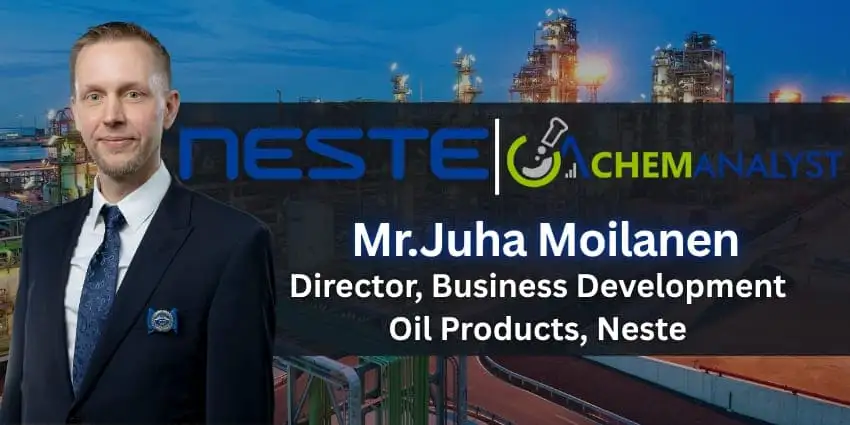Welcome To ChemAnalyst

Their MultiPLHY project at Rotterdam, Netherlands, Facility hosts the world’s largest industrial scale high-temperature electrolyzer that produces green hydrogen.
In the global push toward Decarbonization, Hydrogen is emerging as a crucial enabler for reducing emissions across heavy industries. Among the companies leading this transformation is Neste, a global leader in Renewable Fuels and sustainable feedstocks.
As part of its commitment to achieving carbon neutrality, Neste launched the MultiPLHY project in 2020 with a consortium of partners. The project, located at Neste’s renewable products refinery in Rotterdam, successfully demonstrated the world’s largest high-temperature electrolyzer system (2.6 MW) producing renewable hydrogen for refining operations.
In this interview, Juha Moilanen, Director, Business Development, Oil Products at Neste, discusses the motivation behind the project, the challenges of integrating renewable hydrogen into an existing industrial environment, and how such innovations are shaping the future of low-carbon refining.
1. Give us a little more detail on the MultiPLHY Project.
MultiPLHY, started in early 2020, is a piloting project with consortium partners Neste, Sunfire, CEA, Paul Wurth and ENGIE.
The MultiPLHY project aimed at installing, integrating and operating the world's largest high-temperature electrolyzer system in multi-megawatt-scale (~2.6 MW) in an industrial environment at Neste’s renewable products refinery in Rotterdam to demonstrate production of green hydrogen for the refinery's processes.
The pilot project demonstrated the viability of renewable hydrogen in reducing the use of fossil hydrogen in the Refining Industry.
The project has received funding from the Fuel Cells and Hydrogen 2 Joint Undertaking (now Clean Hydrogen Partnership) under grant agreement No 875123. This Joint Undertaking receives support from the European Union’s Horizon 2020 research and innovation programme, Hydrogen Europe and Hydrogen Europe research.
2. What motivated Neste to pursue renewable hydrogen production at this scale?
Renewable hydrogen is a key to reducing greenhouse gas emissions in our refinery operations. Our participation in the MultiPLHY project provided us valuable knowledge and experience in integrating Electrolyzer solutions into refinery processes, while also further advancing safety practices in renewable hydrogen production. We are closely monitoring advancements in electrolyzer technologies, as improving the cost-competitiveness of renewable hydrogen solutions is essential.
3. What were the biggest challenges in incorporating renewable hydrogen into an existing industrial setup?
In projects of this magnitude, integrating new technology by new suppliers into an established operational refinery environment naturally demanded plenty of time and careful planning and execution, not compromising quality and safety of operations every day.
4. Do you see renewable hydrogen eventually replacing fossil hydrogen entirely in your refining processes?
We are committed to reducing the GHG emissions in our operations, our carbon footprint. Hydrogen plays a crucial role in this, and replacing fossil hydrogen with renewable hydrogen is one of the key means to lower greenhouse gas emissions in refining. We are actively evaluating alternative pathways to utilize renewable hydrogen at our refineries.
5. How do you ensure the continuous and stable supply of renewable hydrogen in your processes?
To establish a renewable hydrogen supply for our refineries, we are assessing a range of development pathways. Realizing the necessary hydrogen ecosystems and supply concepts at scale requires robust cross-sectoral Collaboration.
6. Are there any offtake agreements in place for the renewable hydrogen produced at the MultiPLHY project?
The aim of the demonstration project is to feed the produced renewable hydrogen to Neste’s processes. Hence, offtake agreements are not in the scope of this demonstration project.
7. Which sectors do you see as the biggest consumers of renewable hydrogen in the near future?
Renewable hydrogen provides a scalable and versatile energy source for carbon-intensive processes such as steel, cement, and chemical production. In transportation renewable hydrogen has the potential to become a competitive e-fuel alternative by 2050.
8. What technological innovations or breakthroughs are needed to make hydrogen a mainstream energy solution?
The development of the hydrogen economy in Europe is promising but slow. Investment decisions have been limited due to factors such as rising costs and unclear regulations. The EU has set a target of producing 10 million tons and importing 10 million tons of renewable hydrogen by 2030. While this goal is ambitious, the launch of industrial projects and implementation of legislation take time. However, renewable hydrogen plays a key role in reducing industrial and transportation emissions, offering an almost emission-free alternative to fossil fuels.
The development of the hydrogen economy requires collaboration to improve the competitiveness of green hydrogen, build infrastructure, and create new operating models between industry and technology companies as well as supportive and predictable regulation. In the end, it is the cost and availability of renewable electricity as well as valorisation possibilities of renewable hydrogen which matter.
9. Once the test program validates the performance, what are the next steps for scaling renewable hydrogen at Neste?
The next step in the demonstration project is to carry out a test program that will validate the technology's performance characteristics. This project has been a valuable learning journey, and it has shown the importance of cooperation across the whole value chain.
Neste is committed to reduce the GHG emissions in its operations, and replacing hydrogen produced from fossil raw materials with renewable hydrogen is one of the key means to lower greenhouse gas emissions in refining. We are actively evaluating alternative pathways for utilizing renewable hydrogen at our refineries.
We use cookies to deliver the best possible experience on our website. To learn more, visit our Privacy Policy. By continuing to use this site or by closing this box, you consent to our use of cookies. More info.
